tires MERCEDES-BENZ CLA-Class 2014 C117 Workshop Manual
[x] Cancel search | Manufacturer: MERCEDES-BENZ, Model Year: 2014, Model line: CLA-Class, Model: MERCEDES-BENZ CLA-Class 2014 C117Pages: 358, PDF Size: 6.6 MB
Page 339 of 358
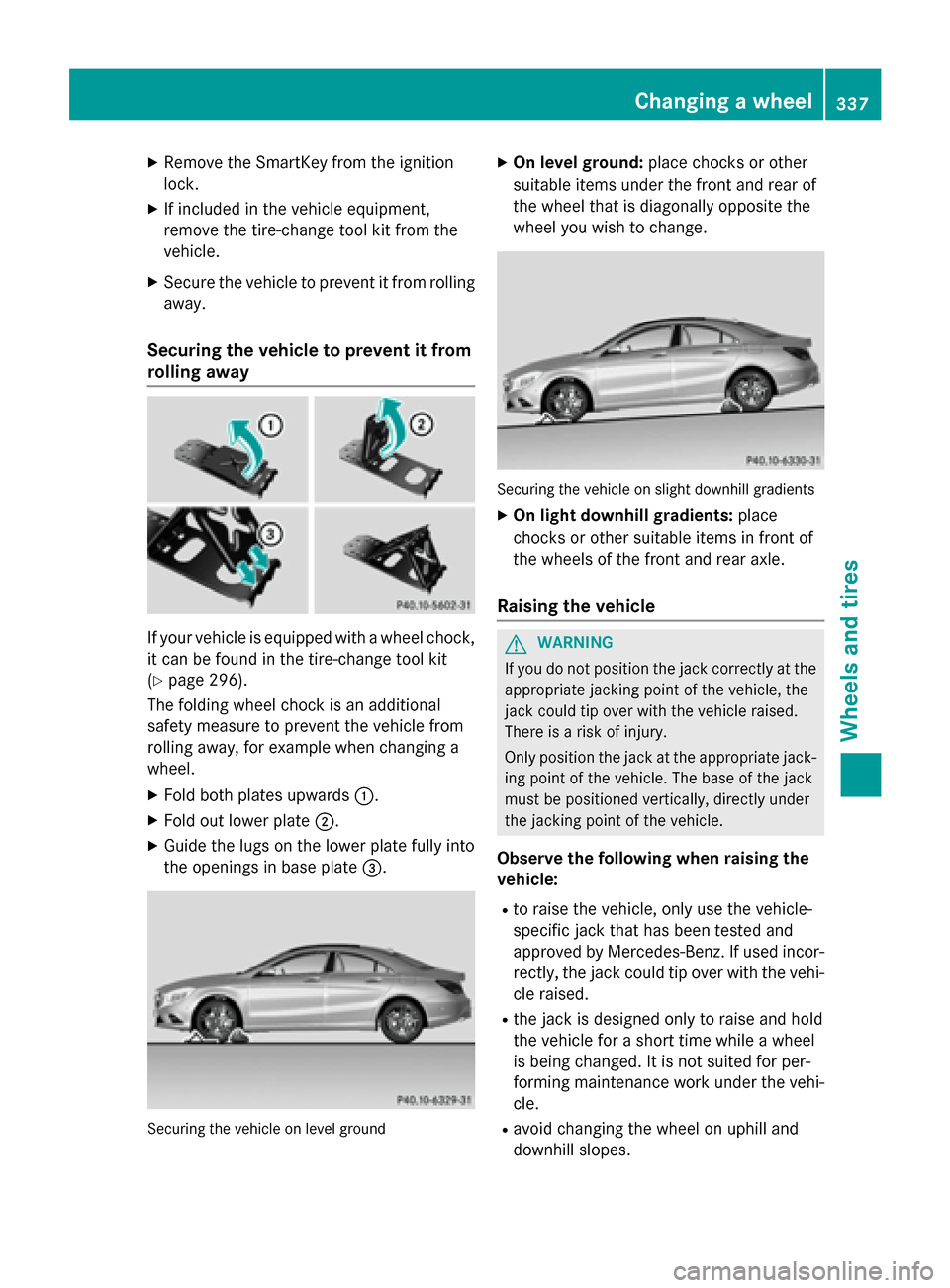
X
Remove the SmartKey from the ignition
lock.
X If included in the vehicle equipment,
remove the tire-change tool kit from the
vehicle.
X Secure the vehicle to prevent it from rolling
away.
Securing the vehicle to prevent it from
rolling away If your vehicle is equipped with a wheel chock,
it can be found in the tire-change tool kit
(Y page 296).
The folding wheel chock is an additional
safety measure to prevent the vehicle from
rolling away, for example when changing a
wheel.
X Fold both plates upwards 0043.
X Fold out lower plate 0044.
X Guide the lugs on the lower plate fully into
the openings in base plate 0087.Securing the vehicle on level ground X
On level ground: place chocks or other
suitable items under the front and rear of
the wheel that is diagonally opposite the
wheel you wish to change. Securing the vehicle on slight downhill gradients
X On light downhill gradients: place
chocks or other suitable items in front of
the wheels of the front and rear axle.
Raising the vehicle G
WARNING
If you do not position the jack correctly at the appropriate jacking point of the vehicle, the
jack could tip over with the vehicle raised.
There is a risk of injury.
Only position the jack at the appropriate jack-
ing point of the vehicle. The base of the jack
must be positioned vertically, directly under
the jacking point of the vehicle.
Observe the following when raising the
vehicle: R to raise the vehicle, only use the vehicle-
specific jack that has been tested and
approved by Mercedes-Benz. If used incor- rectly, the jack could tip over with the vehi-
cle raised.
R the jack is designed only to raise and hold
the vehicle for a short time while a wheel
is being changed. It is not suited for per-
forming maintenance work under the vehi-
cle.
R avoid changing the wheel on uphill and
downhill slopes. Changing a wheel
337Wheels andtires Z
Page 340 of 358
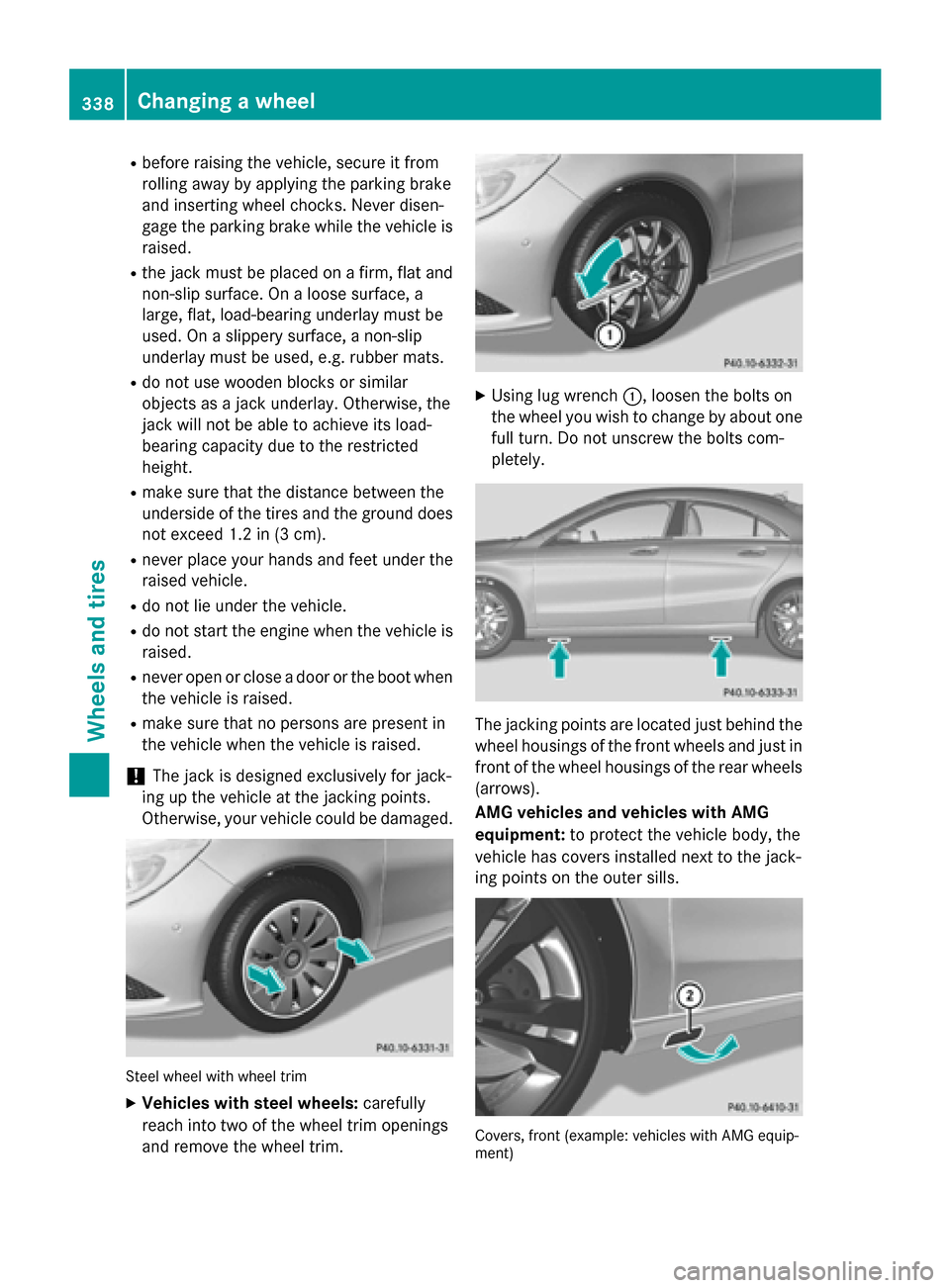
R
before raising the vehicle, secure it from
rolling away by applying the parking brake
and inserting wheel chocks. Never disen-
gage the parking brake while the vehicle is raised.
R the jack must be placed on a firm, flat and
non-slip surface. On a loose surface, a
large, flat, load-bearing underlay must be
used. On a slippery surface, a non-slip
underlay must be used, e.g. rubber mats.
R do not use wooden blocks or similar
objects as a jack underlay. Otherwise, the
jack will not be able to achieve its load-
bearing capacity due to the restricted
height.
R make sure that the distance between the
underside of the tires and the ground does
not exceed 1.2 in (3 cm).
R never place your hands and feet under the
raised vehicle.
R do not lie under the vehicle.
R do not start the engine when the vehicle is
raised.
R never open or close a door or the boot when
the vehicle is raised.
R make sure that no persons are present in
the vehicle when the vehicle is raised.
! The jack is designed exclusively for jack-
ing up the vehicle at the jacking points.
Otherwise, your vehicle could be damaged. Steel wheel with wheel trim
X
Vehicles with steel wheels: carefully
reach into two of the wheel trim openings
and remove the wheel trim. X
Using lug wrench 0043, loosen the bolts on
the wheel you wish to change by about one full turn. Do not unscrew the bolts com-
pletely. The jacking points are located just behind the
wheel housings of the front wheels and just in front of the wheel housings of the rear wheels(arrows).
AMG vehicles and vehicles with AMG
equipment: to protect the vehicle body, the
vehicle has covers installed next to the jack-
ing points on the outer sills. Covers, front (example: vehicles with AMG equip-
ment) 338
Changing a wheelWheels and tires
Page 341 of 358
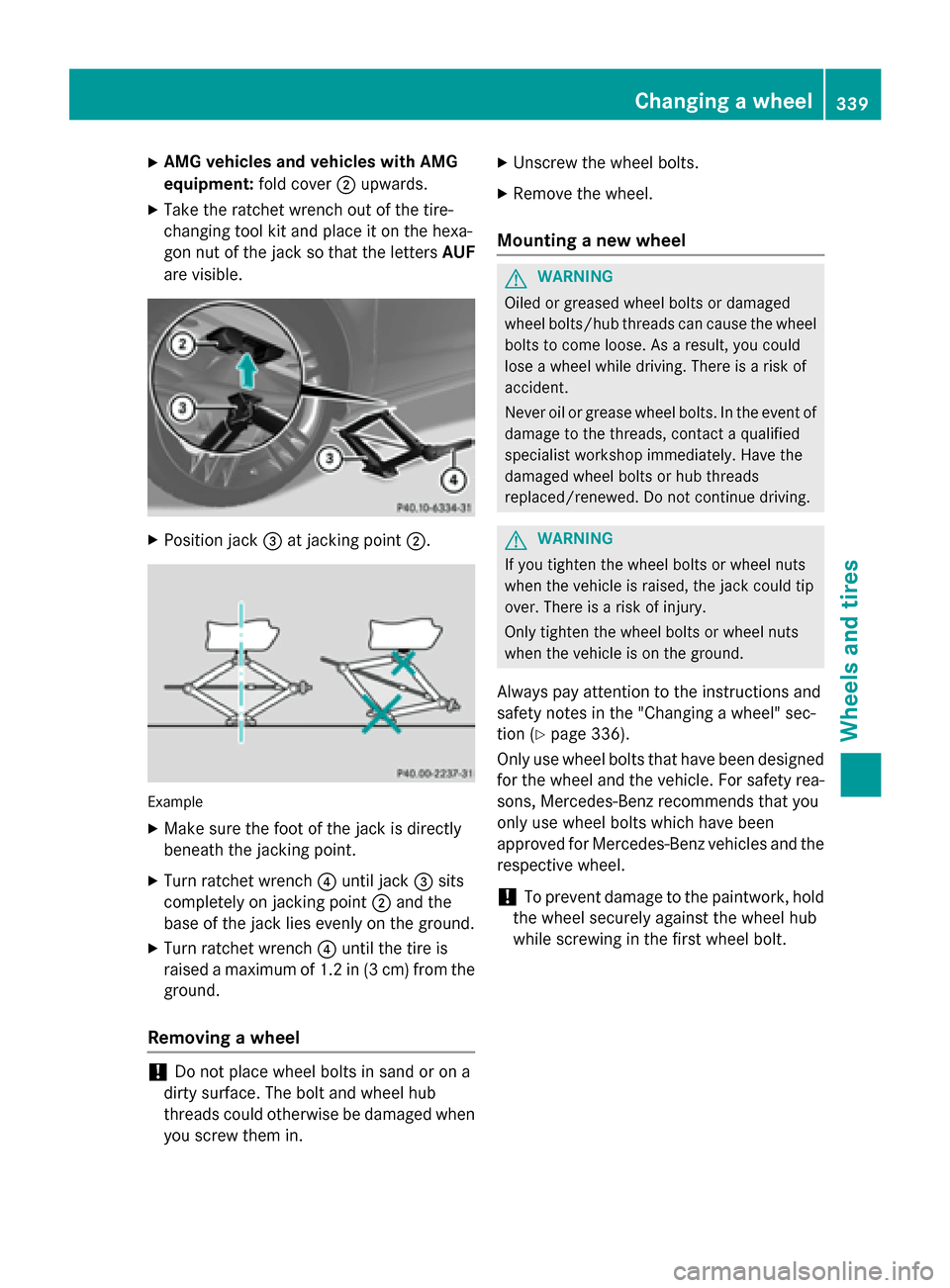
X
AMG vehicles and vehicles with AMG
equipment: fold cover0044upwards.
X Take the ratchet wrench out of the tire-
changing tool kit and place it on the hexa-
gon nut of the jack so that the letters AUF
are visible. X
Position jack 0087at jacking point 0044. Example
X Make sure the foot of the jack is directly
beneath the jacking point.
X Turn ratchet wrench 0085until jack 0087sits
completely on jacking point 0044and the
base of the jack lies evenly on the ground.
X Turn ratchet wrench 0085until the tire is
raised a maximum of 1.2 in (3 cm) from the
ground.
Removing a wheel !
Do not place wheel bolts in sand or on a
dirty surface. The bolt and wheel hub
threads could otherwise be damaged when you screw them in. X
Unscrew the wheel bolts.
X Remove the wheel.
Mounting a new wheel G
WARNING
Oiled or greased wheel bolts or damaged
wheel bolts/hub threads can cause the wheel bolts to come loose. As a result, you could
lose a wheel while driving. There is a risk of
accident.
Never oil or grease wheel bolts. In the event ofdamage to the threads, contact a qualified
specialist workshop immediately. Have the
damaged wheel bolts or hub threads
replaced/renewed. Do not continue driving. G
WARNING
If you tighten the wheel bolts or wheel nuts
when the vehicle is raised, the jack could tip
over. There is a risk of injury.
Only tighten the wheel bolts or wheel nuts
when the vehicle is on the ground.
Always pay attention to the instructions and
safety notes in the "Changing a wheel" sec-
tion (Y page 336).
Only use wheel bolts that have been designed for the wheel and the vehicle. For safety rea-
sons, Mercedes-Benz recommends that you
only use wheel bolts which have been
approved for Mercedes-Benz vehicles and the
respective wheel.
! To prevent damage to the paintwork, hold
the wheel securely against the wheel hub
while screwing in the first wheel bolt. Changing a wheel
339Wheels andtires Z
Page 342 of 358
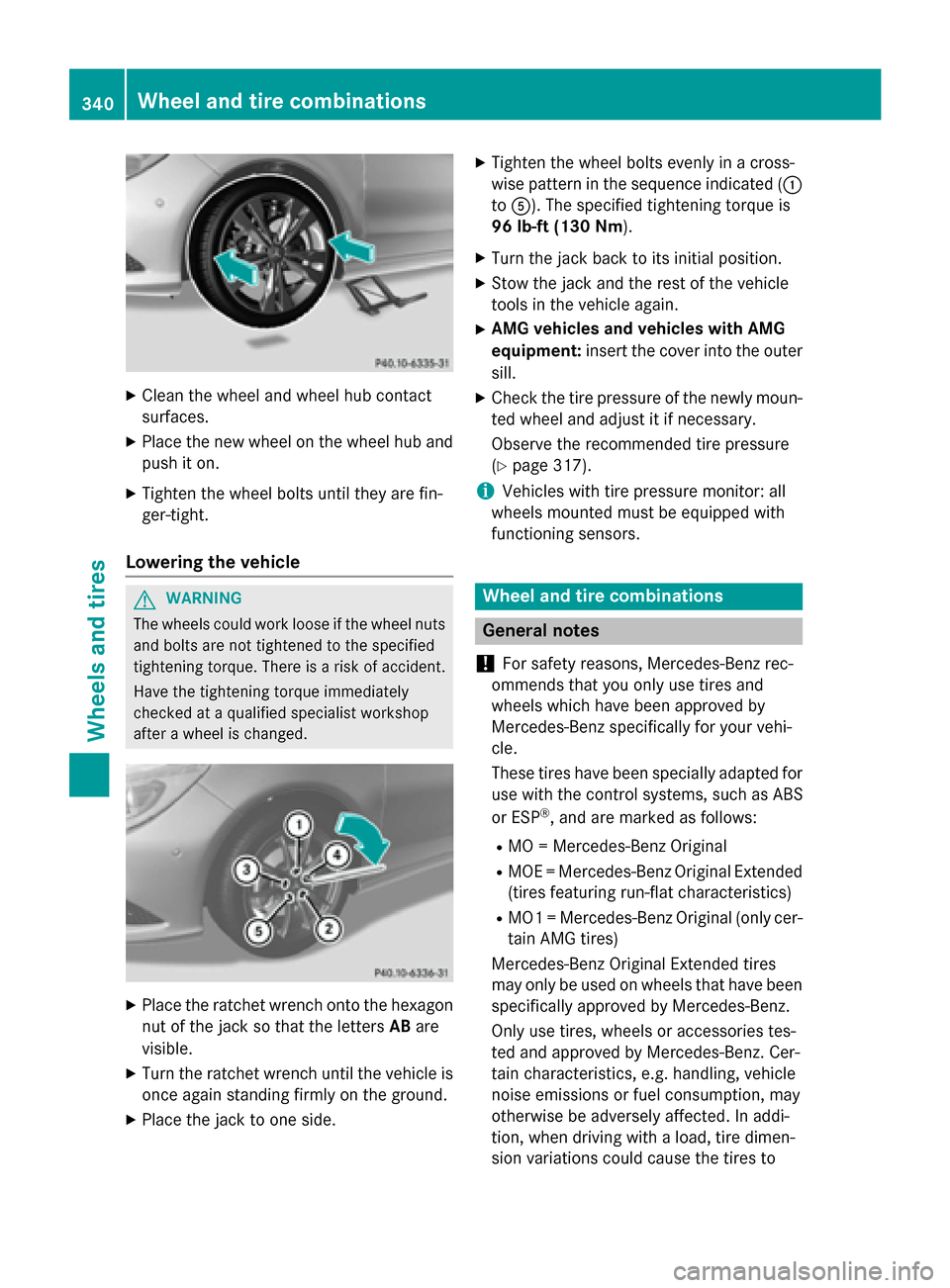
X
Clean the wheel and wheel hub contact
surfaces.
X Place the new wheel on the wheel hub and
push it on.
X Tighten the wheel bolts until they are fin-
ger-tight.
Lowering the vehicle G
WARNING
The wheels could work loose if the wheel nuts and bolts are not tightened to the specified
tightening torque. There is a risk of accident.
Have the tightening torque immediately
checked at a qualified specialist workshop
after a wheel is changed. X
Place the ratchet wrench onto the hexagon
nut of the jack so that the letters ABare
visible.
X Turn the ratchet wrench until the vehicle is
once again standing firmly on the ground.
X Place the jack to one side. X
Tighten the wheel bolts evenly in a cross-
wise pattern in the sequence indicated ( 0043
to 0083). The specified tightening torque is
96 lb-ft (130 Nm ).
X Turn the jack back to its initial position.
X Stow the jack and the rest of the vehicle
tools in the vehicle again.
X AMG vehicles and vehicles with AMG
equipment: insert the cover into the outer
sill.
X Check the tire pressure of the newly moun-
ted wheel and adjust it if necessary.
Observe the recommended tire pressure
(Y page 317).
i Vehicles with tire pressure monitor: all
wheels mounted must be equipped with
functioning sensors. Wheel and tire combinations
General notes
! For safety reasons, Mercedes-Benz rec-
ommends that you only use tires and
wheels which have been approved by
Mercedes-Benz specifically for your vehi-
cle.
These tires have been specially adapted for
use with the control systems, such as ABS
or ESP ®
, and are marked as follows:
R MO = Mercedes-Benz Original
R MOE = Mercedes-Benz Original Extended
(tires featuring run-flat characteristics)
R MO1 = Mercedes-Benz Original (only cer-
tain AMG tires)
Mercedes-Benz Original Extended tires
may only be used on wheels that have been
specifically approved by Mercedes-Benz.
Only use tires, wheels or accessories tes-
ted and approved by Mercedes-Benz. Cer-
tain characteristics, e.g. handling, vehicle
noise emissions or fuel consumption, may
otherwise be adversely affected. In addi-
tion, when driving with a load, tire dimen-
sion variations could cause the tires to 340
Wheel and tire combinationsWheels and ti
res
Page 343 of 358
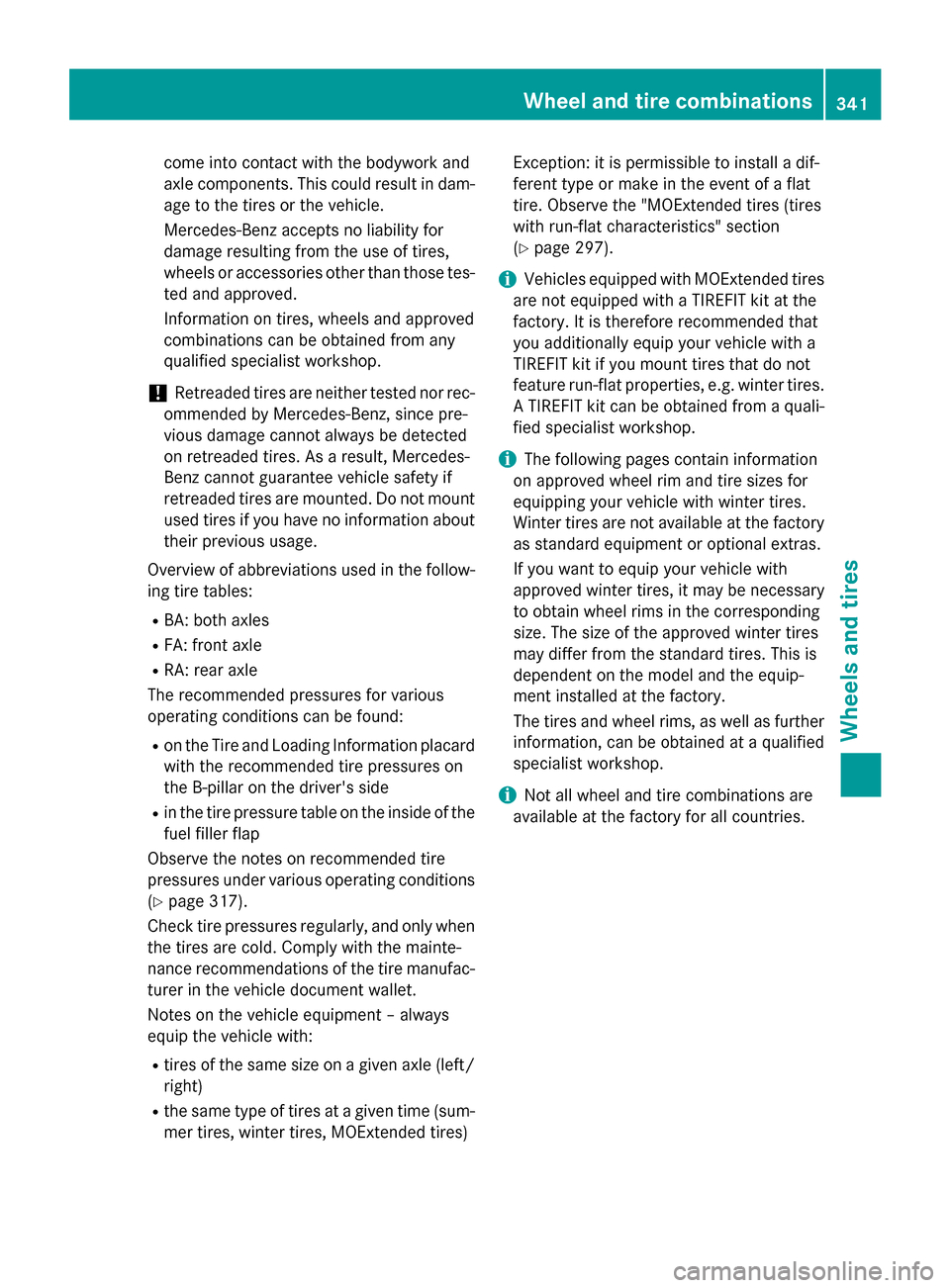
come into contact with the bodywork and
axle components. This could result in dam- age to the tires or the vehicle.
Mercedes-Benz accepts no liability for
damage resulting from the use of tires,
wheels or accessories other than those tes-
ted and approved.
Information on tires, wheels and approved
combinations can be obtained from any
qualified specialist workshop.
! Retreaded tires are neither tested nor rec-
ommended by Mercedes-Benz, since pre-
vious damage cannot always be detected
on retreaded tires. As a result, Mercedes-
Benz cannot guarantee vehicle safety if
retreaded tires are mounted. Do not mount used tires if you have no information about
their previous usage.
Overview of abbreviations used in the follow-
ing tire tables:
R BA: both axles
R FA: front axle
R RA: rear axle
The recommended pressures for various
operating conditions can be found:
R on the Tire and Loading Information placard
with the recommended tire pressures on
the B-pillar on the driver's side
R in the tire pressure table on the inside of the
fuel filler flap
Observe the notes on recommended tire
pressures under various operating conditions (Y page 317).
Check tire pressures regularly, and only when the tires are cold. Comply with the mainte-
nance recommendations of the tire manufac-
turer in the vehicle document wallet.
Notes on the vehicle equipment – always
equip the vehicle with:
R tires of the same size on a given axle (left/
right)
R the same type of tires at a given time (sum-
mer tires, winter tires, MOExtended tires) Exception: it is permissible to install a dif-
ferent type or make in the event of a flat
tire. Observe the "MOExtended tires (tires
with run-flat characteristics" section
(Y
page 297).
i Vehicles equipped with MOExtended tires
are not equipped with a TIREFIT kit at the
factory. It is therefore recommended that
you additionally equip your vehicle with a
TIREFIT kit if you mount tires that do not
feature run-flat properties, e.g. winter tires. A TIREFIT kit can be obtained from a quali- fied specialist workshop.
i The following pages contain information
on approved wheel rim and tire sizes for
equipping your vehicle with winter tires.
Winter tires are not available at the factory as standard equipment or optional extras.
If you want to equip your vehicle with
approved winter tires, it may be necessary
to obtain wheel rims in the corresponding
size. The size of the approved winter tires
may differ from the standard tires. This is
dependent on the model and the equip-
ment installed at the factory.
The tires and wheel rims, as well as further
information, can be obtained at a qualified
specialist workshop.
i Not all wheel and tire combinations are
available at the factory for all countries. Wheel and tire combinations
341Wheels and tires Z
Page 344 of 358
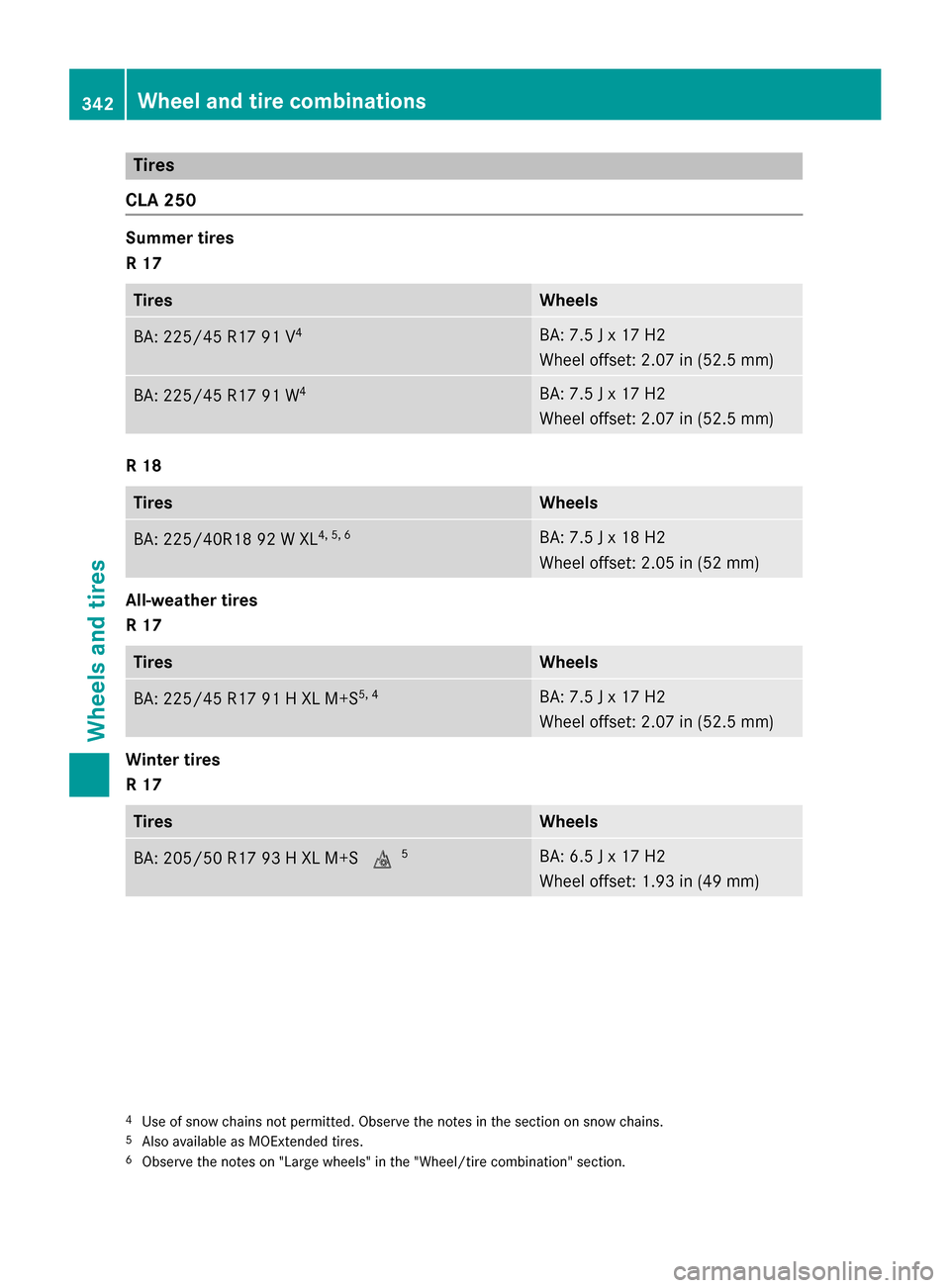
Tires
CLA 250 Summer tires
R 17
Tires Wheels
BA: 225/4
5 R17 91 V 4 BA: 7.5 J x 17 H2
Wheel offset: 2.07 in (52.5 mm)
BA: 225/45 R17 91 W
4 BA: 7.5 J x 17 H2
Wheel offset: 2.07 in (52.5 mm)
R 18
Tires Wheels
BA: 225/40R18 92 W XL
4, 5, 6 BA: 7.5 J x 18 H2
Wheel offset: 2.05 in (52 mm)
All-weather tires
R 17 Tires Wheels
BA: 225/45 R17 91 H XL M+S
5, 4 BA: 7.5 J x 17 H2
Wheel offset: 2.07 in (52.5 mm)
Winter tires
R 17
Tires Wheels
BA: 205/50 R17 93 H XL M+S
004D5 BA: 6.5 J x 17 H2
Wheel offset: 1.93 in (49 mm)
4
Use of snow chains not permitted. Observe the notes in the section on snow chains.
5 Also available as MOExtended tires.
6 Observe the notes on "Large wheels" in the "Wheel/tire combination" section. 342
Wheel and tire combinationsWheels and tires
Page 345 of 358
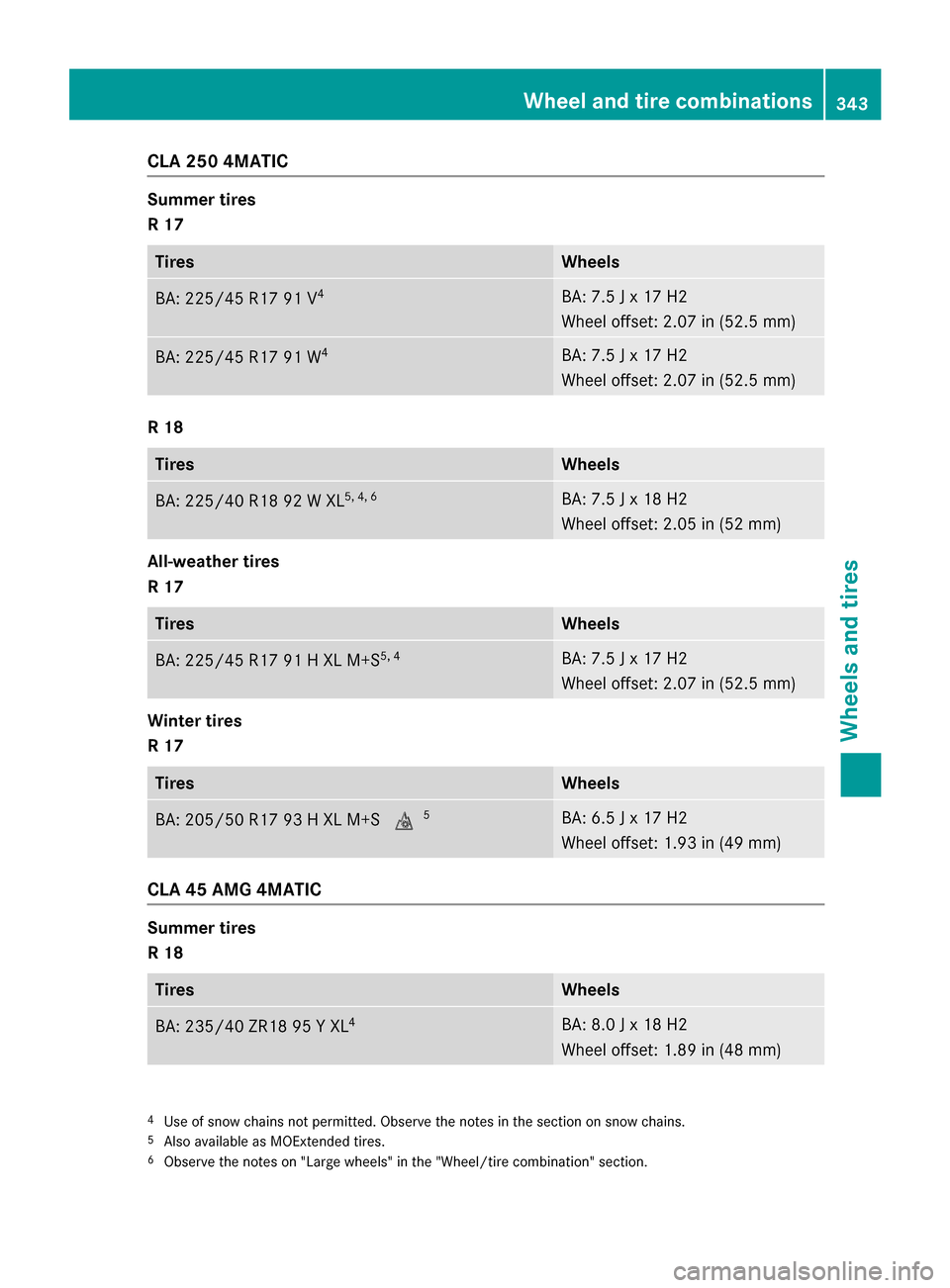
CLA 250 4MATIC
Summer tires
R 17
Tires Wheels
BA: 225/45 R17 91 V
4 BA: 7.5 J x 17 H2
Wheel offset: 2.07 in (52.5 mm)
BA: 225/45 R17 91 W
4 BA: 7.5 J x 17 H2
Wheel offset: 2.07 in (52.5 mm)
R 18
Tires Wheels
BA: 225/40 R18 92 W XL
5, 4, 6 BA: 7.5 J x 18 H2
Wheel offset: 2.05 in (52 mm)
All-weather tires
R 17 Tires Wheels
BA: 225/45 R17 91 H XL M+S
5, 4 BA: 7.5 J x 17 H2
Wheel offset: 2.07 in (52.5 mm)
Winter tires
R 17
Tires Wheels
BA: 205/50 R17 93 H XL M+S
004D5 BA: 6.5 J x 17 H2
Wheel offset: 1.93 in (49 mm)
CLA 45 AMG 4MATIC
Summer tires
R 18
Tires Wheels
BA: 235/40 ZR18 95 Y XL
4 BA: 8.0 J x 18 H2
Wheel offset: 1.89 in (48 mm)
4
Use of snow chains not permitted. Observe the notes in the section on snow chains.
5 Also available as MOExtended tires.
6 Observe the notes on "Large wheels" in the "Wheel/tire combination" section. Wheel and tire combinations
343Wheels and tires Z
Page 346 of 358
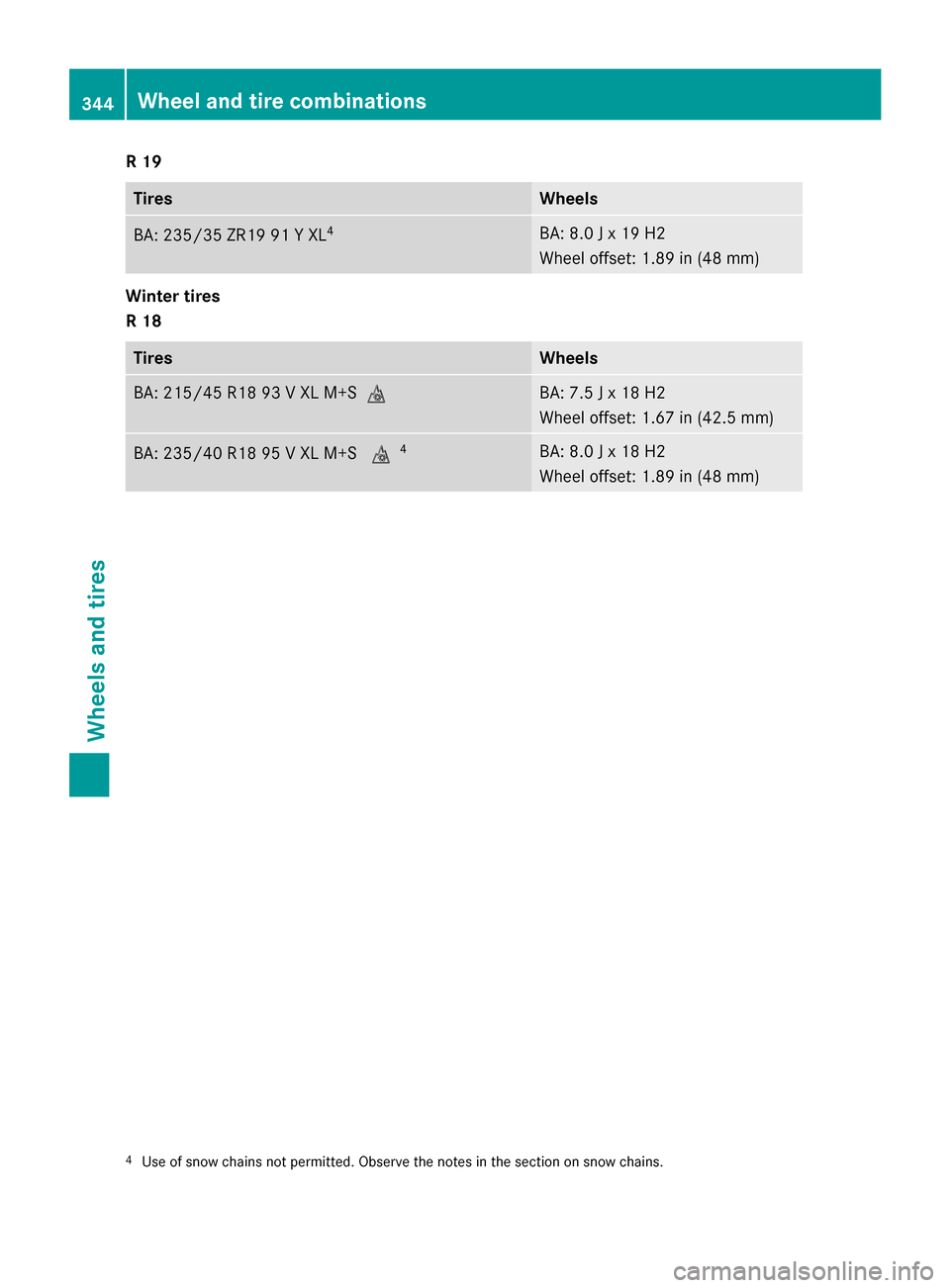
R 19
Tires Wheels
BA: 235/35 ZR19 91 Y XL
4 BA: 8.0 J x 19 H2
Wheel offset: 1.89 in (48 mm)
Winter tires
R 18
Tires Wheels
BA: 215/45 R18 93 V XL M+S004D BA: 7.5 J x 18 H2
Wheel offset: 1.67 in (42.5 mm)
BA: 235/40 R18 95 V XL M+S
004D4 BA: 8.0 J x 18 H2
Wheel offset: 1.89 in (48 mm)
4
Use of snow chains not permitted. Observe the notes in the section on snow chains. 344
Wheel and tire combinationsWheels and tires
Page 355 of 358
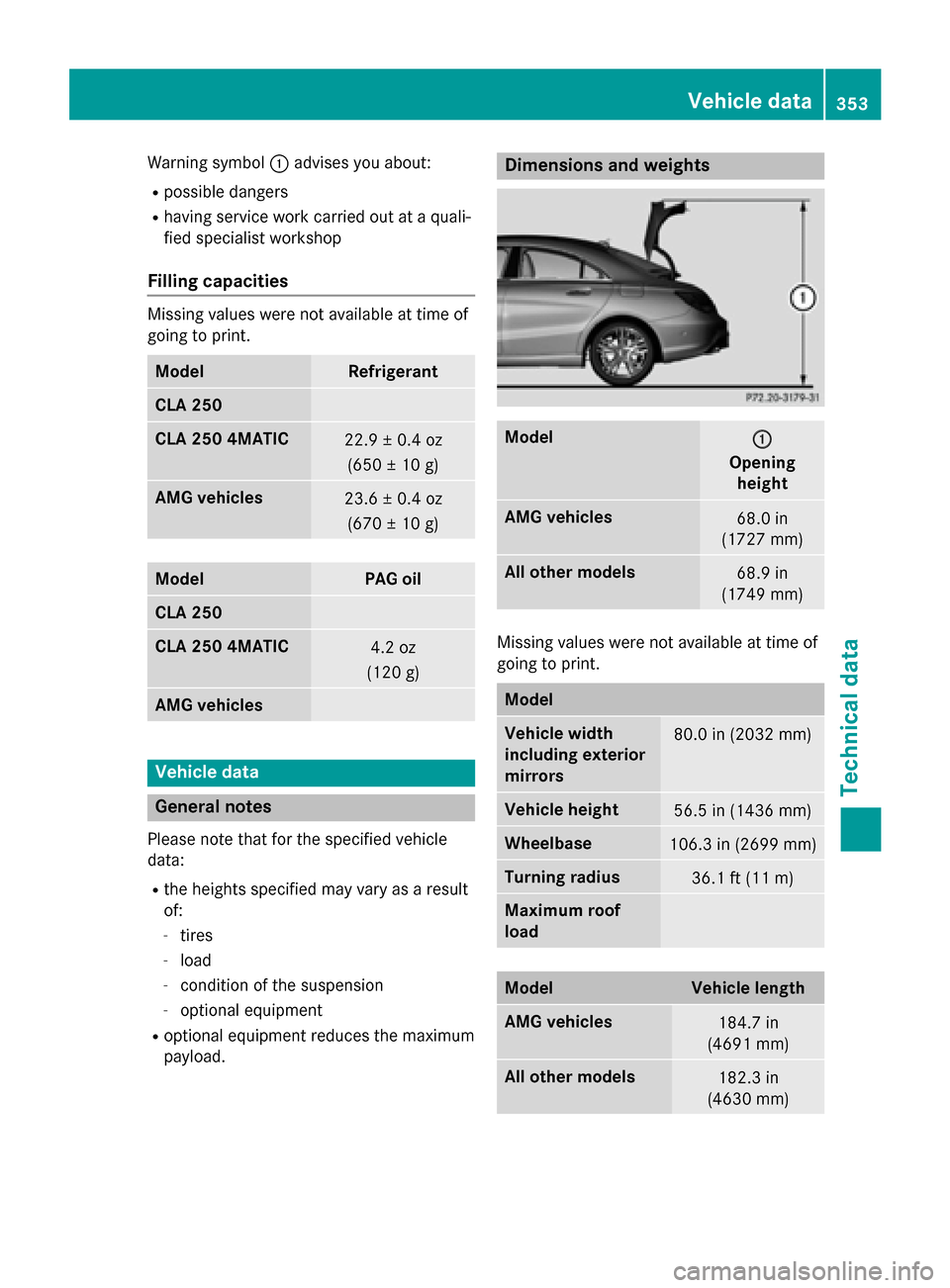
Warning symbol
0043advises you about:
R possible dangers
R having service work carried out at a quali-
fied specialist workshop
Filling capacities Missing values were not available at time of
going to print. Model Refrigerant
CLA 250
CLA 250 4MATIC
22.9 ± 0.4 oz
(650 ± 10 g) AMG vehicles
23.6 ± 0.4 oz
(670 ± 10 g) Model PAG oil
CLA 250
CLA 250 4MATIC
4.2 oz
(120 g) AMG vehicles
Vehicle data
General notes
Please note that for the specified vehicle
data: R the heights specified may vary as a result
of:
- tires
- load
- condition of the suspension
- optional equipment
R optional equipment reduces the maximum
payload. Dimensions and weights
Model
0043 0043
Opening height AMG vehicles
68.0 in
(1727 mm) All other models
68.9 in
(1749 mm) Missing values were not available at time of
going to print.
Model
Vehicle width
including exterior
mirrors
80.0 in (2032 mm)
Vehicle height
56.5 in (1436 mm)
Wheelbase
106.3 in (2699 mm)
Turning radius
36.1 ft (11 m)
Maximum roof
load
Model Vehicle length
AMG vehicles
184.7 in
(4691 mm) All other models
182.3 in
(4630 mm) Vehicle data
353Technical data Z